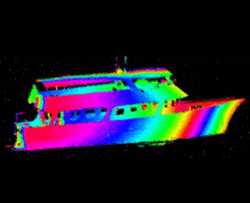Navy going after pirates with new robot copters
Aerial bots will use cutting-edge technology and unique software to scan the seas for pirates
Attention pirates — you can run, but pretty soon, you won’t be able to hide anymore. That’s because the U.S. Navy plans to deploy robot helicopters capable of identifying pirate boats from up above — even when the vessel is sitting in a crowded sea lane.

New technology developed by the U.S. Navy will allow aerial bots to identify hostile vessels from up above.
It’s an excellent example of how robotics and machine learning is opening up new applications in the modern world, especially when it comes to security and surveillance.
I spy a hiding pirate
The aerial bots are referred to as Multi-Mode Sensor Seekers (MMSS). There’s a wide array of data collecting technology on-board, including high-definition cameras, mid-wave infrared sensors, and laser-radar (LADAR), the latter of which sends lasers beams onto an object and processes the signal echoed from the target to create a 3-D image. (In case anyone out there’s wondering, the Office of Naval Research said the lasers are “eye safe.”)
From there, the MMSS uses advanced automatic target recognition software to compare the 3-D imagery to vessel templates or schematics recorded in the system’s memory. This, in turn, helps the bot identify hostile vessels from friendly ones.
“The 3-D data gives you a leg up on target identification,” said Dean Cook, principal investigator for the MMSS program at Naval Air Warfare Center Weapons Division. “Infrared and visible cameras produce 2-D pictures, and objects in them can be difficult to automatically identify. With LADAR data, each pixel corresponds to a 3-D point in space, so the automatic target recognition algorithm can calculate the dimensions of an object and compare them to those in a database.”
Greater efficiency
The MMSS will significantly reduce the workload of sailors, who will now be tasked with operating the bots from control stations aboard the Navy ships.
Previously, the Navy identified pirates by deploying both drones with cameras and human pilots. This process proved ineffective in coastal areas with a lot of boats, as it isn’t exactly easy to differentiate a hostile vessel from a regular boat on sight. A sailor might have to go through hours of video to find the right one, checking captured data against a group of known silhouettes. It’s not an exact science, per se, especially since a boat could be at an angle, making things harder to identify.
“Sailors who control robotic systems can become overloaded with data, often sifting through hours of streaming video searching for a single ship,” said Ken Heeke, program officer in ONR’s Naval Air Warfare and Weapons Department. “The automatic target recognition software gives Fire Scout (name of one of the MMSS’s) the ability to distinguish target boats in congested coastal waters using LADAR, and it sends that information to human operators, who can then analyze those vessels in a 3-D picture.”
So far, so good
The technology has been tested in shore-based systems against vessels at sea and has so far proven to be very effective. The next step is to test the software aboard a manned helicopter against seven small boats in a military sea range off the California coast this summer. ■
Advertisement
Learn more about Electronic Products Magazine





